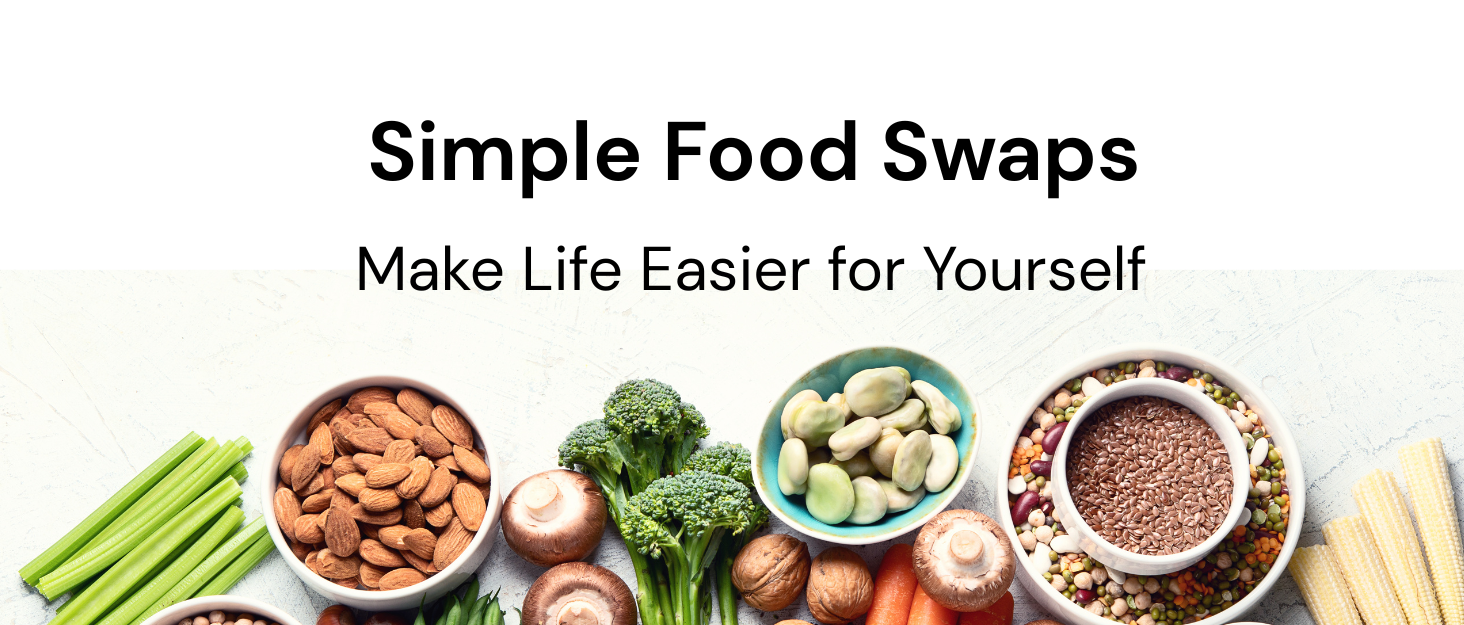Overwhelmed what to do to lose weight? I mean who really wants to start their day calculating macros to lose weight – not me for sure. Yes food groups matter, as do calories, as do when we eat (as do many other variables), but surely there has to be a simpler way for busy women to be able to eat without fork in one hand and calculator in the other. Instead focus on food group pairings. It really could be the deal-breaker in seeing the changes you want, or not.
How we combine our food is pretty much usually dictated by our taste buds, but once we clear our plate, our food is in our body anywhere between 14 to 58 hours.
That bolus of food makes it’s way down the esophagus to your stomach for digestion and breakdown in your digestive tract all whilst dictating how your body responds, signalling our fat storage hormone on / off ‘switch’ and more importantly affects our metabolic health. If you think about it we keep our body pretty busy with just eating!
So what do you think about when you decide what to eat. What influences you? Take a second to ask yourself…Is it set weekly, planned in advance, an ingrained lifestyle routine on loop? Or are you more of a winger, with emotions or daily circumstance getting more of a say?
Do you follow the masses and simply rotate your favourite (10 or so) meals? Taking turns rotating other family member’s favourites?
Do calories play a role? Or do you just tell yourself they do? Because most of us overeat – right…
Is there always veggies on your plate? And for those yes’ers feeling smug, does that include breakfast and lunch too? (And if it does you can 100% feel smug, because most of us don’t eat anyway where near enough fibre).
Because what’s on our plate is much more than just calories. The pairing of carbohydrates, fats, and proteins influences how quickly food is digested, how full we feel, and how our blood sugar and insulin respond. It could be the difference to you losing weight or gaining weight.
By understanding food pairings, you can improve energy, reduce cravings, support long term weight management (no more diets), and even lower your risk of metabolic issues.
Here you’ll learn:
- Why There's More to Your Plate Than Just Calories
- The Impact of Carbs and Fat Storage Hormone Insulin
- How Combining High-Carb + High-Fat Meals Stall Weight Loss
- How to Pair Carbohydrates Wisely
- The Role of Proteins in Food Group Pairings
- The Role of Fats in Food Group Pairings
- What To Add To Sweet Treats
- Food Group Pairings
Why Food Pairings Matter to your Body
When we eat, our body breaks food down into glucose (from carbs), amino acids (from protein), and fatty acids (from fats). How quickly these nutrients enter the bloodstream depends on the combination of food group on your plate.
- Carbs alone tend to cause a sharp rise in blood sugar and insulin.
- Adding protein or fat slows digestion, blunts the glucose spike, and keeps you fuller for longer.
- Certain food combinations can even increase the absorption of key nutrients, like pairing healthy fats with fat-soluble vitamins (A, D, E, K).
Why it matters: The way food group are paired affects energy levels, satiety, blood sugar balance, and long-term metabolic health.
How Carbs, Glucose, and Insulin Work
When you eat carbohydrates, they’re broken down into glucose (sugar), which enters the bloodstream.
- This rise in glucose signals the pancreas to release insulin, a hormone that helps shuttle glucose into cells for energy.
- If your cells don’t need the extra glucose right away, insulin directs the surplus to be stored as glycogen in muscles and the liver.
- Once glycogen stores are full, excess glucose is converted into fat for long-term storage.
- Insulin is a double edge sword – we need it to shuttle glucose and give us energy and nutrients from our food, but when it’s busy the body is NOT is fat burning mode.
Why it matters: Regularly eating more carbs than your body needs—especially refined carbs—leads to frequent insulin spikes and more fat storage over time .
The Impact of High-Carb + High-Fat Meals
Individually, carbs or fats are not inherently “bad.” But when they’re eaten together in large amounts, the body responds differently.
- High carb + high fat meals (e.g., pizza, fries, pastries, burgers) cause blood sugar spikes from carbs + fat storage signals from insulin.
- Because fat is more than double the calories of protein or carbs (9 calories per gram), excess energy from these meals is more easily stored as body fat. (protein and carbs are 4 calories per gram)
- Studies suggest this combination encourages overeating, as the mix of sugar and fat strongly activates the brain’s reward system .
Why it matters: Meals high in both refined carbs and fats may be the most fat-storing and hardest to resist—contributing to weight gain and metabolic problems over time.
The Role of Carbohydrates in Food Group Pairings
Carbohydrates are the body’s main energy source. They are all digested into glucose, which triggers insulin release.
- Refined carbs (white bread, pastries, sugary drinks) are absorbed quickly, leading to sharp blood sugar and insulin spikes.
- Whole carbs (brown rice, oats, beans) contain fibre, which slows absorption and reduces glucose peaks.
- When carbs are paired with protein or fat, digestion slows further, leading to steadier blood sugar.
Why it matters: Pairing carbs wisely can help stabilise blood sugar, prevent energy crashes, and reduce cravings.
The Role of Proteins in Food Group Pairings
Proteins are broken down into amino acids, which are building blocks for muscles, enzymes, and hormones.
- Protein stimulates the release of glucagon, which balances insulin.
- When combined with carbs, protein slows gastric emptying and reduces the glycaemic response.
- Protein increases satiety hormones, helping reduce overeating.
Why it matters: Adding protein to meals helps control hunger, reduce blood sugar spikes, and support muscle health.
The Role of Fats in Food Group Pairings
Dietary fats are digested more slowly than carbs or protein, and they don’t directly raise blood sugar.
- Fats slow gastric emptying, which can flatten glucose and insulin curves.
- Healthy fats (olive oil, avocado, nuts) improve absorption of fat-soluble vitamins and antioxidants.
- Pairing fats with refined carbs, however, can amplify insulin-driven fat storage.
Why it matters: Pairing fats with vegetables and protein enhances nutrition, while combining fats with refined carbs can be harmful.
Food Group Swaps – Smarter Ways to Enjoy Treats
Completely cutting out treats isn’t realistic—or enjoyable. Instead, you can balance your indulgences by pairing them smartly.
Examples of Smarter Treat Pairings
- Berries + Ice Cream → Fibre from berries slows sugar absorption.
- Dark Chocolate + Almonds → Healthy fats and protein blunt the glucose spike.
- Cookie + Glass of Milk → Protein helps balance cookie carb absorption.
- Fruit + Greek Yogurt → Protein and probiotics for better satiety.
- Cake + Handful of Walnuts → Adds fibre, protein, and omega-3s.
Why it matters: You don’t have to give up desserts—pairing them with protein, fibre, or healthy fats helps reduce sugar spikes and keeps energy stable.
Food Group Pairings
✅ Good Food Group Pairings
- Oats + Nuts/Seeds → Slower glucose release, sustained energy.
- Rice + Chicken + Vegetables → Balanced blood sugar, more satiety.
- Salad + Olive Oil or Avocado → Better absorption of vitamins and antioxidants.
- Apple + Peanut Butter → Protein and fat help blunt sugar spike from fruit.
- Wholegrain Toast + Egg + Spinach → Balanced mix of carbs, protein, and fibre.
❌ Bad Food Group Pairings
- Sugary Drinks + Fast Food Burger/Fries → High fat + high refined carbs = insulin spike and fat storage.
- Pastry + Coffee with Sugar → Quick glucose surge followed by energy crash.
- White Bread + Jam → Rapid glucose release without protein or fat buffer.
- Doughnuts or Cake → Refined carbs with added fats = poor metabolic response.
Why it matters: Choosing the right food pairings helps you feel fuller, energised, and metabolically balanced, while poor pairings can trigger energy crashes, cravings, and fat storage.
Frequently Asked Questions (FAQs) About Food Group Pairings.
1. Why is food pairing important for blood sugar?
Food pairings affect how quickly glucose enters your bloodstream. Pairing carbs with protein or fat slows digestion and helps prevent blood sugar spikes.
2. What are the best foods to pair with carbs?
Protein-rich foods (chicken, eggs, fish, legumes) or healthy fats (avocado, nuts, olive oil) are excellent pairings to help balance blood sugar and insulin response.
3. Is it bad to eat carbs alone?
Eating carbs alone, especially refined ones, can cause quick spikes in blood sugar and insulin. While not always harmful, doing so regularly may contribute to cravings, fatigue, and weight gain.
4. Do food pairings affect weight loss?
Yes. Balanced pairings reduce hunger and prevent overeating, which supports weight management. Poor pairings (like refined carbs with fats) may promote fat storage.
5. Does combining fat with vegetables really help?
Yes. Healthy fats like olive oil or avocado increase absorption of fat-soluble vitamins (A, D, E, K) and antioxidants found in vegetables.
Menopause Tablets for Weight Loss – 3 for 2 Offer
Menopause tablets for weight loss – 3 for 2 offer. Perimenopause supplements & menopause shaping balance, get all the benefits of MENO PLUS a fantastic cost saving with this limited time 3 for 2 offer. Please note that other promotional offers do not apply to sale products.
Fibre Tablets
High fibre pills derived from psyllium husk, flaxseed, sugar beet, prune juice, fig fruit, rhubarb, pectin, fenugreek and other naturally high fibre botanicals and foods. More than just roughage, these fibre pills contains cellulose, pectin, hemicellulose, lignin and gums.
Fibre Pills Ingredients: Psyllium Husk, Flaxseed, Sugar Beet Fibre, Fenugreek, Apple pectin, Rhubarb, Prune Juice, Broccoli, Carrot, Fig Fruit, Fennel Seed. Vegan, Dairy Free, Gluten Free. 100 capsules
Food Group: References
- Brown, M. J., et al. (2004). Carotenoid bioavailability is higher from salads ingested with full-fat dressing than with fat-reduced dressing or no fat. Am J Clin Nutr, 80(2), 396–403.
- Collier, G., & O’Dea, K. (1983). The effect of co-ingestion of fat on the glucose, insulin, and gastric inhibitory polypeptide responses. Am J Clin Nutr, 37(6), 941–944.
- Granfeldt, Y., et al. (1992). The glycaemic index of foods: A physiological basis for carbohydrate exchange. Diabetologia, 35(6), 526–528.
- Ludwig, D. S. (2002). The glycemic index: Physiological mechanisms relating to obesity, diabetes, and cardiovascular disease. JAMA, 287(18), 2414–2423.
- Lundsgaard, A. M., et al. (2020). The effect of a high-fat, high-carbohydrate meal on metabolism. J Physiol, 598(4), 755–768.
- Nuttall, F. Q., & Gannon, M. C. (1991). Plasma glucose and insulin response to macronutrients. Diabetes Care, 14(9), 824–838.
- Small, D. M. (2009). Individual differences in the neurophysiology of reward and the obesity epidemic. Int J Obes, 33(S2), S44–S48.
- Weigle, D. S., et al. (2005). A high-protein diet induces sustained reductions in appetite, caloric intake, and body weight. Am J Clin Nutr, 82(1), 41–48.






